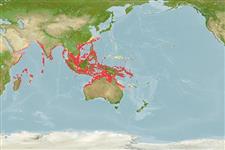Common names from other countries
>
Eupercaria/misc (Various families in series Eupercaria) >
Caesionidae (Fusiliers) > Gymnocaesioninae
Etymology: Dipterygonotus: Greek, di = two + Greek, pteryx = fin + Greek, gono, gone = birth + Greek, noton = back (Ref. 45335).
More on author: Valenciennes.
Environment: milieu / climate zone / depth range / distribution range
Ecología
marino asociado a arrecife; rango de profundidad 37 - 91 m (Ref. 26165). Tropical; 28°N - 24°S, 43°E - 163°E (Ref. 402)
Indo-Pacific: East Africa, not including the Red Sea or Arabian (Persian) Gulf, to the Solomon Islands.
Tamaño / Peso / Age
Maturity: Lm ? range ? - ? cm
Max length : 14.0 cm TL macho / no sexado; (Ref. 402)
Espinas dorsales (total) : 12 - 15; Radios blandos dorsales (total) : 8 - 11; Espinas anales: 3; Radios blandos anales: 9 - 11.
Primarily a near-shore pelagic species (Ref. 30573), but swims mainly in open water away from reefs (Ref. 48636). Forms dense aggregations (Ref. 90102). Mixed with other planktivores and is easily overlooked. Feeds on zooplankton (Ref. 30573). Oviparous, with numerous, small pelagic eggs (Ref. 402). Caught at night using lights and dip nets (Ref. 30573). Important tuna bait fish in some countries (Ref. 30573).
Life cycle and mating behavior
Maturities | Reproducción | Spawnings | Egg(s) | Fecundities | Larva
Carpenter, K.E., 1987. Revision of the Indo-Pacific fish family Caesionidae (Lutjanoidea), with descriptions of five new species. Indo-Pac. Fish. (15):56 p. (Ref. 1723)
IUCN Red List Status (Ref. 130435)
Warning: mysqli::__construct(): (08004/1040): Too many connections in /var/www/html/includes/func_getlabel.php on line 46
Can't connect to MySQL database (fbapp). Errorcode: Too many connections
